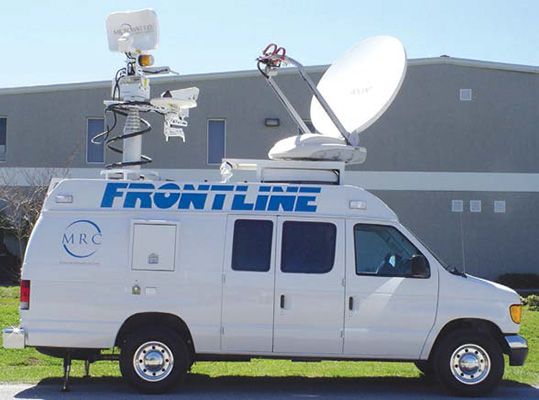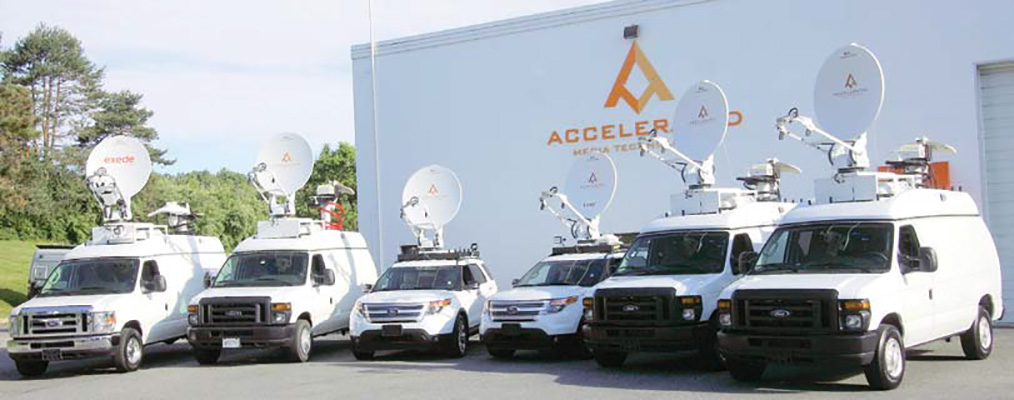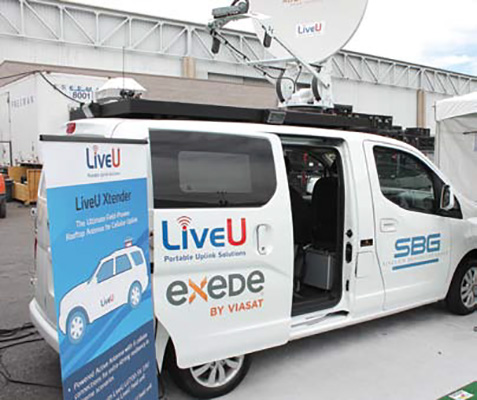The New ‘Hybrid’ ENG

Hybrid transmission products, such as Vislink’s NewStream, combine microwave, satellite and cellular technologies and are used in vans like this one from Frontline.
SEATTLE—For the past half-dozen years, bonded cellular technology—the backpack liveshot systems using the cellphone systems for transmission—have garnered most of the attention of the TV news crowd. But in the background, more traditional microwave and satellite liveshot equipment and the trucks that house it have continued to thrive.
With the well-known advantages bonded cellular enjoys, price, portability, quick connection and so forth, what’s behind the demand for microwave and satellite? One reason is control.
“The primary reason for TV stations having their own signal path is that they can control it,” said Sunil Naik, director of engineering at microwave radio supplier Moseley Associates Inc. in Santa Barbara, Calif. “Any issues that occur [on a microwave system], they know how to handle it internally. On the cellular network, when the network goes down, they have no recourse.”
In the end, it really comes down to having a connection ENG crews can count on, according to Brad Coleman, director of marketing at microwave equipment builder Broadcast Microwave Services in Poway, Calif. “The resources that are involved with a microwave connection are federally managed,” he said. “The allocation, use and the licenses, that provides that connection that’s there, that’s less impacted by the heavy use of cellular systems, and it’s just inherently more reliable. There’s substantial value in that.”
‘JUST ANOTHER TOOL’
It’s not just a matter of getting crowded out of the cellular bandwidth at a location. As anyone who’s driven back country roads and tried to make a call knows, there are plenty of places where there is no cellular network coverage, and news stories have a habit of happening right in those out-of-the-way spots.

Accelerated Media recently deployed a fleet of IP cellular-bonded vehicles using LiveU, Dejero and Viasat Ka enterprise service to Fox O&O stations. With all that in mind, there’s still little denying among traditional liveshot equipment vendors that bonded cellular units have a place in covering breaking news, but they insist bonded cellular isn’t the whole answer. “I think news departments consider bonded cellular just another tool,” said Rex Reed, director of business and product development at news truck builder E-N-G Systems in Concord, Calif. “I think news people feel that [bonded cellular] won’t work at the big event, that if everybody with bonded cellular show up at the same place, at the same time, everything will be oversaturated.”
Get the TV Tech Newsletter
The professional video industry's #1 source for news, trends and product and tech information. Sign up below.
The scenario on a breaking news story seems to work like this. When an event first happens, news teams rushing to the scene can quickly fire up their portable bonded cellular equipment without worrying about establishing a line-of-sight microwave path or aiming a satellite dish. But as more electronic journalists arrive and people in a gathering crowd begin to send selfies and whatnot from the location, cellular bandwidth for the liveshot can become iffy. The answer is somewhere inbetween: to use the best of both old and new technology to create a “hybrid ENG” scenario.
“Broadcasters looking to expand their video toolkit now have the option of hybrid transmission products which combine technologies, such as microwave, cellular, and satellite, as well as more powerful outdoor units,” said Jacqueline Roy, vice president of marketing at microwave equipment maker Vislink in North Billerica, Mass. Different pieces of liveshot technology can hand the liveshot transmission duties seamlessly between one another as one path degrades and another is ready to get the signal back to the studios.
BOTH HAVE THEIR LIMITATIONS
It’s not a one-way street when it comes to a signal path degrading, where it’s always the cellular networks that become unreliable. Rain fade on a satellite dish or the need to lower a microwave antenna mast in a storm can open the door to bonded cellular units riding to the rescue.
Bonded Cellular, Vanmakers Link Up
Recently, traditional microwave and satellite liveshot equipment and truck builders have been integrating the newer bonded cellular liveshot equipment into their systems. In a turnabout, companies like bonded-cellular pioneers LiveU and TVU Networks have begun to package their cellular network equipment into ENG vehicles outfitted with satellite and microwave capabilities.
“We can build bonded cellular and Kaband satellite capability into smaller trucks, which are not as expensive, can reach more places because they’re all-terrain, are easier to park and so on,” said Ken Zamkow, head of marketing for the U.S. and the Americas for LiveU in Hackensack, N.J.

At the NAB Show this year, LiveU displayed a new ENG van built by AMT for Sinclair, featuring the LiveU Xtender and the LU700. Not only does this combination provide the advantages of bonded cellular—like going live while the vehicle is en route to breaking news, and on-site portability—the advantages of Ka satellite mean that ENG crews won’t see their lifeblood bandwidth eaten up by cellphone users sending pictures home to mom.
Combining the two technologies into a news truck system yields additional capabilities. For example, a LiveU liveshot backpack such as its LU500 can accompany the cameraman up to several hundred yards from the truck, transmitting via the cellular networks back to the studios. But if the condition of the cellular network degrades to where it threatens that liveshot path, the LU500 can transmit wirelessly back to a LiveU LU700 encoder in the truck. From there the liveshot can be routed to cell towers that might not be as busy, or into the Ka dish for satellite delivery.
In a similar move, cellular liveshot maker TVU Networks, a Mountain View, Calif.-based developer of mobile IP video solutions, and truck builder Frontline Communications unveiled the Frontline Cellular/Microwave/Satellite IP Vehicle Solution at the Texas Association of Broadcasters convention earlier this month.
Frontline’s IP Vehicle Solution (IPVS) will be installed as standard equipment in any of Frontline’s broadcast vehicle platforms. TVU’s MLink can simultaneously aggregate multiple IP data connections, including Ka or Ku band satellite, microwave, WiFi and 3G/4G/LTE cellular, to transmit live HD video at sub-second latency.
“Frontline ENG vehicles will be able to deliver stable, reliable HD video from anywhere under virtually any condition,” said Jonathan Sherr, vice president, Frontline Communications.
TV news operations can expect to see more and more of these combinations as liveshot equipment providers and ENG vehicle makers race to deliver the best and most flexible (and affordable) tools for the job.
Craig Johnston
A good example of a spot news story that grew into multi-day live coverage was last month’s flood at the UCLA campus. “What seemed like a routine water main break developed into a front-page story for the whole country,” said Stephen Williamson, director of broadcast sales for ENG vehicle manufacturer Frontline Communications in Clearwater, Fla. “Full-sized vans and helicopters deployed for over two days on this story to cover the emergency response and damage from the flood.”
There are other advantages to a hybrid news truck. “New developments such as mast mounted cellular antenna configurations combine the signal strength of bonded cards with the height of the mast delivering enhanced network access on a more robust scale,” Roy said.
Some stories that news crews cover are predictably going to lead to cellular liveshot failure. “Bonded cellular is good for spot news, but they have issues when you try to do sports, or any type of large event where multiple people show up,” said Thomas Jennings, president of Accelerated Media Technologies (AMT) in Auburn, Mass. “So the trend we’ve had in the last year has been to mate cellular bonding technology with Kasatellite technology, and we’ve been turning out Ka trucks like they’ve been doing out of style.” Ka satellite technology is smaller and less expensive than Ku equipment, and the space time costs less. (See sidebar)
Another advantage that an ENG van brings is creature comfort. Along with the ability to transport and deploy liveshot gear at a news location, these vehicles also often have workspace for a reporter and laptop, not to mention a heater for one weather extreme and an air conditioner for the other.
Veterans who have worked out of ENG vans will note an old-reliable rig that has ridden into the sunset, the Ford E-350. Williamson from Frontline, noted three candidates for its replacement: The Ram ProMaster, the new full sized Ford Transit and the Nissan NV. Frontline’s engineering group rated the three for ENG/DSNG applications: Ram ProMaster-Strong, Ford Transit- Stronger, Nissan NV-Strongest.
ENG’s Reed pointed out that technology for the vehicles themselves advances at a relative snail’s-pace compared with liveshot electronics. “But you still have to deal with all the essential vehicle issues,” he said. “And while the size of the vehicle varies some, fundamentally you still have to have power, you still have to have a place for people to sit, you still have to observe all of the rules of the road, and the laws of physics and gravity, those kinds of things.”
Williamson is bullish on the future of ENG vehicles, which “are evolving with the industry with new technology and capabilities, and continue to be a valuable tool in journalism and broadcasting, now and into the foreseeable future.”
